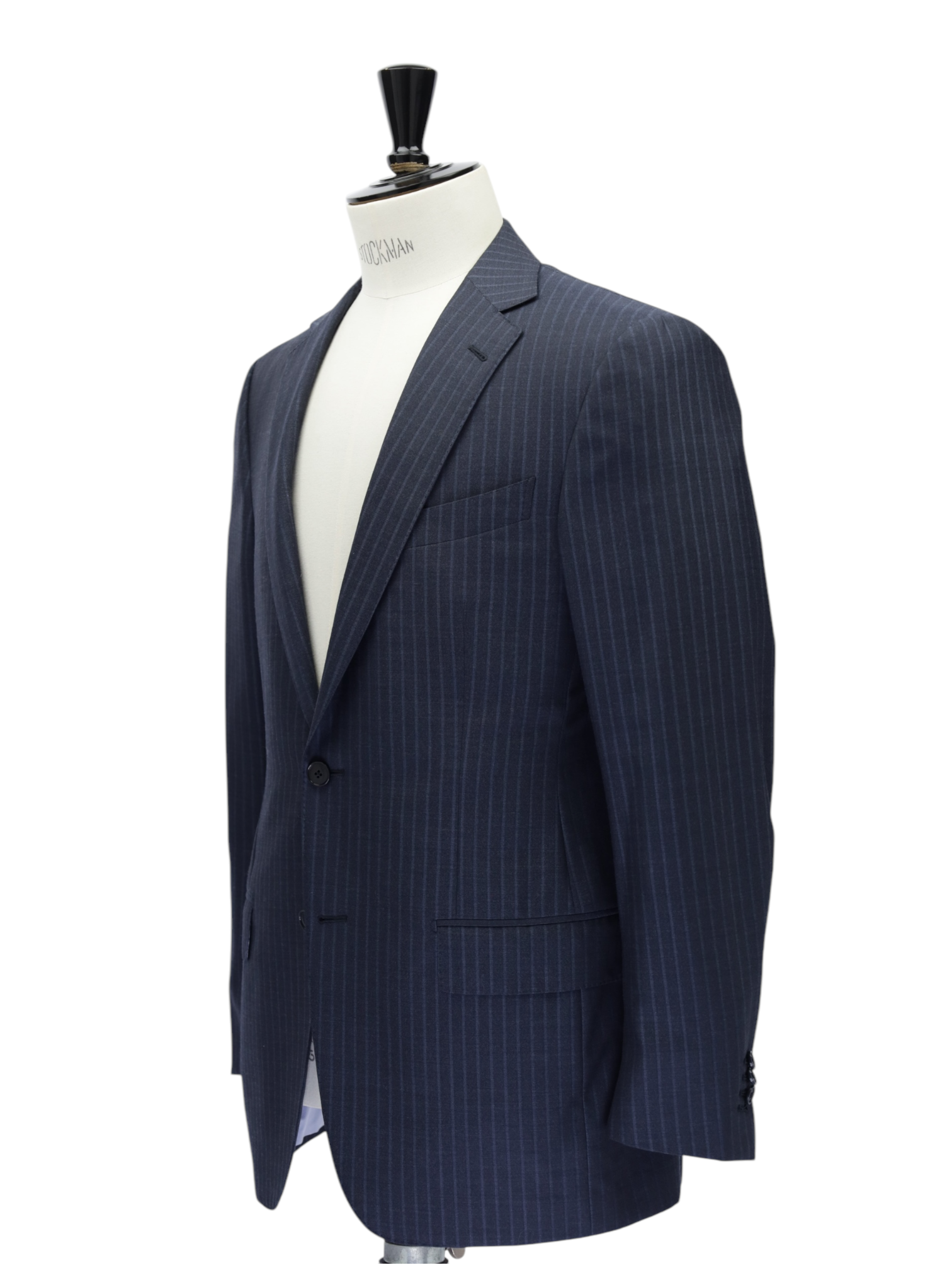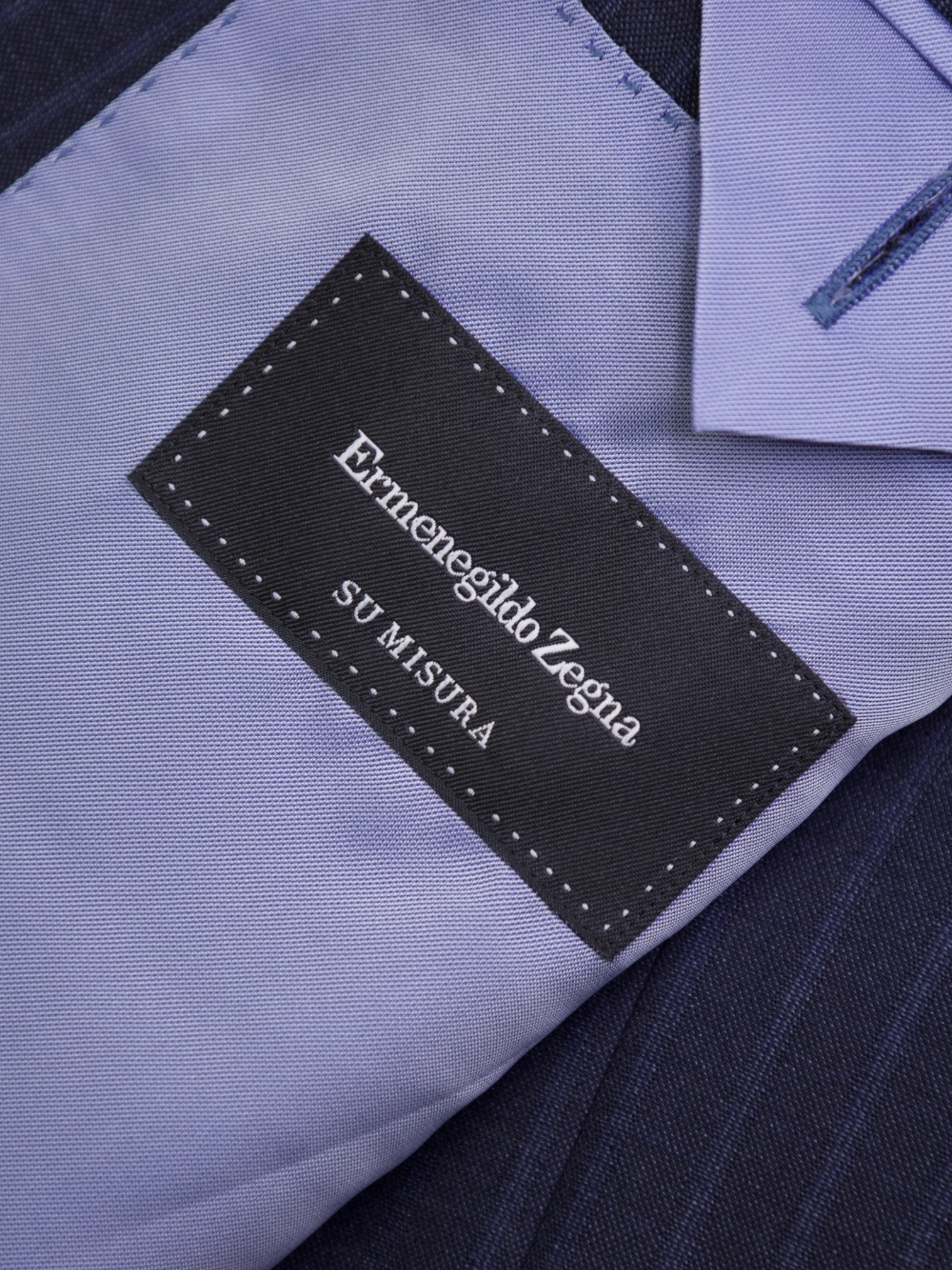






Ermenegildo Zegna Blue Wool & Silk Trofeo 600 Pinstripe Suit
52 IT / 42 US / Large
Discover the Ermenegildo Zegna Blue Wool & Silk Trofeo 600 Pinstripe Suit, a sophisticated blend of modern elegance and timeless style. Crafted in Zegna’s exclusive Trofeo 600 fabric, this suit combines premium wool with a hint of silk for an exceptionally smooth, breathable texture that feels luxurious against the skin. The rich blue tone is accentuated with fine pinstripes, creating a balanced look that’s polished without being overly formal. The jacket’s classic notch lapel and full lining provide a structured drape, ideal for both business engagements and refined social events.
Every aspect of this suit is a testament to Ermenegildo Zegna’s legacy in luxury menswear. The Trofeo 600 fabric is celebrated for its durability and softness, developed by Zegna’s skilled artisans who are renowned for their meticulous attention to detail. Precision-cut panels and hand-finished seams speak to the brand’s commitment to excellence, while the understated pinstripe adds a timeless charm. This suit captures Zegna’s dedication to Italian craftsmanship, ensuring you look impeccably tailored for any occasion. Discover the elaborated sartorial details below.
Composition: 85% Wool / 15% Silk
Color: Blue
Pattern: Pin-Stripe
See how we measure our sartorial items
Discover the customization possibilities by visiting our tailor alteration guide
Gratis verzending voor bestellingen boven de 200€ in Nederland, 500€ in de EU en 1000€ buiten de EU.
Verzendkosten voor bestellingen onder de minimumprijs zijn afhankelijk van je land.
General Note: While we inspect each item to ensure its quality, please note that minor imperfections may be present due to the preloved nature of the garments. We strive to represent every item accurately, but subtle signs of wear may sometimes go unnoticed. We appreciate your understanding and commitment to sustainable luxury.
Opties kiezen








Ontdek de
Sartoriale Details

Full Canvas Constructie
Een sartoriale jas - of mantel - heeft een tussenvoering nodig die helpt om de vorm te geven en het te modelleren. Canvas geeft het item een op maat gemaakte en ambachtelijke uitstraling. Kortom, het brengt leven in het kledingstuk. Technisch gezien is canvas gemaakt van paardhaar, wol, mohair of kamelenhaar. Het kan ook een mix van deze materialen zijn, met variërende dikte en gewicht. De canvas wordt aan de jas gestikt, vaak met de hand, waardoor de canvasstukken 'zweven' tussen de binnen- en buitenstof. Dit geeft de jas extra flexibiliteit. De canvas loopt van de bovenste delen helemaal door tot het einde van de jas. Nadat je je canvasjas een tijd hebt gedragen, zal deze beginnen de vorm van je lichaam aan te nemen en er ongelooflijk natuurlijk uitzien.

Gerolde Schouders
Een "gerolde" schouder - of mouwkop - beschrijft de verhoogde vorm of richel van de bevestiging van de mouw aan de schouder. Hoe hoger het is, hoe imposanter de schouderlijn lijkt. Dit kan vaak worden gevonden in iconisch Brits kleermakerswerk.

Handgemaakt Knoopsgat
Handgemaakte knoopsgaten worden gemaakt met behulp van een ketting van geknoopte lussen, genaamd festonsteken, die ze sterk en visueel onderscheidend maken. Het duurt ongeveer vijf seconden om met een machine een normaal knoopsgat te naaien - een enkel handgemaakt knoopsgat kost ongeveer 10 minuten om te naaien.

Tweeknoops Sluiting
Het jasje heeft een sluiting met twee knopen waardoor het profiel strak blijft.

Borstzak - Afgeronde Paspelzak
Ook bekend als 'barchetta', Italiaans voor 'bootje', wordt het zo genoemd omdat deze zak zweeft op de borst, lichtjes schuin omhoog, net als de boeg van een zeilboot. Deze zakken echoën de levendige rol van een revers die de veerkracht van canvas en natuurlijke wol draagt, in tegenstelling tot machinaal gemaakte borstzakken die een meer platte, rechthoekige vorm hebben en minder leven.

Naden
De kleermaker voegt twee figuurnaden toe - denk aan ze als ingeknepen naden - om ervoor te zorgen dat het lichaam van het jasje een slank silhouet krijgt. Het proces, genaamd "mezzo punto riprese", wordt volledig met de hand uitgevoerd.

Hoornen Knopen
Hoornen knopen worden gewaardeerd om hun kwaliteit. Ze zijn gemaakt van het beste echte hoornmateriaal, wat de uitstraling van het pak verbetert. En omdat ze zo sterk zijn, hoef je je geen zorgen te maken dat ze barsten of breken.

Klepzakken
Dit was oorspronkelijk bedoeld om te voorkomen dat vuil in de jaszakken terechtkomt wanneer deze op het platteland wordt gedragen. Klepzakken bevinden zich min of meer in het midden wat betreft formaliteit: ze zijn een voor de hand liggende keuze voor zakelijke pakken, maar ze kunnen ook voorkomen op blazers als eerbetoon aan hun informele oorsprong.
de details van
de broek

Flat Front
Flat-front trousers are a go-to for a modern, clean look. They became popular in the 1960s and 1970s when fashion started leaning towards simpler, more streamlined styles. Unlike pleated pants, flat fronts have no extra fabric at the waist, giving them a sleek appearance that's perfect for a slimmer silhouette. They fit right into both casual and business casual settings, making them incredibly versatile. As a result, they are a favorite for anyone looking to maintain a contemporary vibe in their wardrobe.

Belt Loops
Belt loops are the most common type of waistband found on trousers, providing the option to wear a belt for both style and practicality. Typically spaced evenly around the waistband, belt loops are a versatile feature that can accommodate a wide range of belt styles and sizes. This traditional waistband design is found in everything from casual jeans to formal dress pants, making it a timeless and adaptable option for any wardrobe. Belt loops offer the flexibility to customize your look while ensuring a secure fit.

Turn-Up (Cuffed) Hem
The turn-up hem, or cuffed hem, is a classic style where the fabric at the bottom of the trousers is folded outward to create a visible cuff. This style originated with Edward VII in the late 19th century, who had his trousers tailored with cuffs to prevent them from getting muddy, sparking a trend among the fashionable elite. In the 1920s and 1930s, turn-ups became a symbol of wealth and sophistication, as having extra fabric was seen as a luxury. This association continued after World War II when wearing turn-ups subtly indicated affluence in an era of fabric rationing. Today, turn-up hems are a nod to their historical roots, offering a touch of classic elegance and enhancing the overall appearance of formal and tailored trousers.


maat
52 IT / 42 US / Large


 Curator's Description
Curator's Description Materialen
Materialen